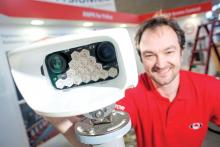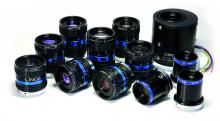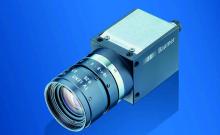The transportation sector is set to benefit from a far wider range of machine vision technology. While machine vision techniques have been applied to traffic management applications for some years, in some areas there can still be a shortage of knowledge about what the technology can offer transportation professionals. The image processing and interpretation functions of machine vision enables control room staff to be immediately alerted to occurrences requiring attention which, in turn, enables each person
Machine vision techniques enable multiple checks, classifications and images to be made simultaneously.
The transportation sector is set to benefit from a far wider range of machine vision technology
While machine vision techniques have been applied to traffic management applications for some years, in some areas there can still be a shortage of knowledge about what the technology can offer transportation professionals. The image processing and interpretation functions of machine vision enables control room staff to be immediately alerted to occurrences requiring attention which, in turn, enables each person to monitor more cameras.
Misconceptions about increased bandwidth requirements can deter authorities from pursuing machine vision solutions whereas the reality is that bandwidth requirements are often reduced because live video does not have to be continuously streamed to the control room. Furthermore, power-over-Ethernet (PoE) is being used to enable ‘one-cable’ installations which can drastically reduce installation costs in remote areas.
Historic attitudes in the traffic management sector have traditionally seen cameras as a commodity – imposing a constant, downward pressure on prices and prolonging a dependence on analogue cameras. And although a degree of machine vision can be grafted into analogue cameras, the possibilities are far greater with digital images.
The battle between the lower cost CMOS' sensors and the higher priced/higher quality CCD continues although the consensus is that the quality gap between the technologies is narrowing.541 Point Grey, for instance, is using a 2.3 megapixel CMOS sensor from 576 Sony with a global shutter in its Grasshopper3 family of USB3 Vision cameras. It says the technology avoids the distortion of rolling shutter technology, is extremely fast and sensitive, and offers 1920 x 1200 resolution at up to 162 frames per second.
Another company using CMOS technology is593 Teledyne Dalsa which recently unveiled compact CMOS line scan sensor technology in its new Linea monochrome cameras. Available in 2K and 4K resolution, the cameras deliver line rates of 80kHz with including transportation safety.
78 JAI also remained loyal to CMOS incorporating the technology in its latest VISCAM 1000 because, according to the company, it ‘eliminates problems with smearing that can reduce the readability of images captured with CCD cameras’. The camera incorporates a 5 megapixel (2560 x 2048) 72fps CMOS sensor with global shutter enabling it to produce readable plate images across multiple traffic lanes. It comes with video triggering, light sensing and dynamic range control and is available in monochrome or colour versions.
The trend towards higher resolution sensors not only improves image sharpness, it also enables the live image to be subdivided into multiple areas of interest and the application of machine vision allows each area to be analysed differently. So at a junction with two lanes of traffic travelling in each direction not only can each number plate be automatically located and identified, the complete contextual image can be simultaneously captured.
A prime example is592 Tattile’s latest mobile ANPR camera which the company says can scan more than 100 number plates per second, front and rear and in any light condition. The plates are read in the camera and transmitted via Wi-Fi while the software enables simultaneous image acquisition both in colour and monochrome.
The company’s Vega Colour camera has embedded technology that not only recognises number plate characters but also the colour of the plate which can be useful in identifying the vehicle’s country/state of origin. Likewise4347 Quercus Technologies’ latest SmartLPR Access is able to read the text number and state as well as capturing colour images. “Not only is this feature of great importance for the US market, but also it increases the reliability of the recognition results in some Arabian countries,” said Edu Gil, Car Access sales manager in the EMEA.
The colour/monochrome requirement is highly important where there is a legislative need for colour contextual images which precludes the use of infrared flash in low light conditions. As number plates are usually made from highly reflective material, this compounds the problems (especially for analogue cameras) at night as the brightness range between the flash-illuminated scene and the reflective number plate is too high to capture in one image. With machine vision systems the electronics can identify the licence plate area and process the data from that section of the sensor accordingly to produce an image that contains both the contextual view and the number plate.
One such is Gardasoft which says its VCT6 Series single-board illuminators enables OEMs in the ITS sector to realise the full capabilities of machine vision systems at night. Available in various wavelengths including white light and infrared, each modular board contains high intensity LEDs and driver circuits, optics and remote communications. The LEDs are triggered by Gardasoft’s pulse and strobe system which can capture successive images of vehicles – even if they are travelling at high speed.
Another example of machine vision is536 Sick’s combination of laser-based 3D modelling and infrared imaging in its latest vehicle hotspot detector, the VHD Pro. The electronics system overlays the 3D model with the infrared thermal image to differentiate between allowable hot spots (such as engines and transmissions) and others in the brakes or load which could result in a fire. It automatically detects a worrying hot spot in less than five seconds and alerts operatives to divert the troubled vehicle before it can enter a tunnel or board a ferry or train.
65 Imagsa Technologies’ stereoscopic system uses machine vision techniques to analyse 270 images per second with 2048 x 1024 pixel resolution (2 megapixel) to determine vehicle speed - including motorcycles running between lanes. According to Imagsa’s sales director Xavier Miota, the equipment requires no other sensor to function and is also capable of reading licence plates and classifying vehicles.
83 Kria also use the 3D ‘stereo’ vision approach and it has halved the distance between the two cameras to 33cm. “This isn’t just miniaturisation for the sake of it – we’re still managing to have a wider footprint, allowing six parallel lane events to be addressed,” said company president Stefano Arrighetti. In addition to speed detection the system can also be used for section control, dangerous goods tracking, black/whitelisting and enforcing illegal manoeuvres including right-turn-on-red.
By combining 3D radar with digital imaging and machine vision techniques,143 Truvelo’s latest D-Cam R can track up to 64 vehicles at any one time (approaching or receding). It also differentiates vehicles by class and applies the appropriate speed limit to each and all vehicles passing the camera are tracked and speed checked to provide statistical data for the highway authority.
The above are good examples of the latest generation of multi-functional cameras – another is the XCamEdge automatic incident detection system from371 Citilog. This was initially developed for intersection control applications including presence detection and its capabilities have been expanded to queue monitoring and anti-gridlock applications. This latest configuration includes more processing power, H264 encoding and HD video streaming enabling it to also cover applications including incident detection and wrong way driving.
In a similar vein is6778 Flir’s latest high definition (HD) version of its Automatic Incident Detection (AID) cameras called TrafiBot HD. The processing unit uses video analytics to generate traffic data and incident detection information and automatically alerts traffic operators to stopped vehicles, wrong way drivers, pedestrians, lost cargo and smoke.
And in periods when the camera is not detecting an incident, the company says the system generates zero network traffic. Such is the improvement in definition and the processing capabilities of machine vision that where once four or even eight cameras were needed to cover an intersection, this can now be done with one or two – which does much to offset price premium and boost availability as well as drastically reducing the bandwidth requirement.
Another example is521 CA Traffic’s EVO-X which is an ANPR camera that can deliver live video streaming including pan-tilt-zoom capability. Its field of view covers three lanes and the processing capability means it can read retro and non-retro plates simultaneously and comes with a full range of communications options - including 4G.
Developing a new machine vision application is604 Vysionics with its Vector LX which it describes as ‘an entirely new enforcement solution for rail crossings’. This combines ANPR with scanning radar and video capture and is currently in the advanced stages of UK type approval.
Economies of scale are not only coming from multifunctional cameras but also with control systems. For instance the latest high definition automatic number plate recognition system from112 Redflex uses a single camera to cover two lanes of traffic and up to four additional camera modules can be added to a single camera control unit. It says the system is ideal for applications from car park and restricted lane monitoring to tolling, travel time calculation and surveillance.
Sodi’s latest Autovelox 106 goes beyond simple speed enforcement and can also detect tailgating, bus and emergency lane violation, minimum speed and cars-only zones. Equipped with an 18 megapixel camera the system captures one or two images per infraction plus all necessary violation data on roads with up to four lanes. It can be used at a fixed site or in mobile configuration without modification.
Aiming at the tolling companies,43 Efkon is utilising machine vision technology in its automatic toll sticker monitoring system to recognise the N-Force windscreen tolling sticker and automatic identification of toll violators. The company says development of high-precision image analysis systems has seen an enormous increase in the enforcement rate and provides excellent performance even under critical light and weather conditions
In Europe the EU is to adopt a new cyber-security framework and data protection rules by 2015.
According to data protection law expert Kathryn Wynn of Pinsent Masons, the rules will not outlaw particular functions but will make it more difficult to get approval for technology that can track, trace or identify individuals.
“A monitoring or surveillance system has to be proportionate to the problem it is being installed to combat - authorities must keep this in mind. So a Privacy Impact Assessment must individually consider each aspect of a multifunction camera [or other technology]. Any function that is considered disproportionate will have to be removed or disabled,” she says.
However, machine vision can make the situation simpler as the cameras will only transmit details of offending vehicles while overwriting and obliterating all others.
From 2015 the new regulations will require a higher level of protection for all data linked to an individual – in transport terms that means in particular number plate details collected for tolling, parking, travel time calculations or enforcement purposes. According to Wynn ‘secure’ and ‘restricted’ are the key words.
She says authorities in the EU will still be able to capture and hold data identifying offending vehicles but without incriminating individuals not accused of wrongdoing, such as the passenger in a speeding car. Where a system gathers more evidence than required – for instance showing a driver’s face as well as the registration details - the additional evidence can also be held in secure storage.
Privacy assured
Machine vision techniques can help combat tighter privacy and data protection requirements by including or excluding parts of an image to prevent information regarding non-offending vehicles entering the system. For its part 4186 Xerox has developed technology that does not read the number plate as much as recognise the rear of the vehicle. Aimed primarily at tolling and parking companies, the system compares a new image of the back of the vehicle with similar images of cars belonging to registered users. The matching algorithm includes items such as stickers in the rear screen or dents in the bodywork and when a match is found the user can be billed in the normal way.
While the image does capture the number plate, in the first instance the system uses other factors to identify the vehicle and therefore avoids many of the privacy and data protection pitfalls. This may also be useful in countries where ANPR is politically difficult or where there is a variety of fonts or a high proportion of non-domestic vehicles.
While machine vision techniques have been applied to traffic management applications for some years, in some areas there can still be a shortage of knowledge about what the technology can offer transportation professionals. The image processing and interpretation functions of machine vision enables control room staff to be immediately alerted to occurrences requiring attention which, in turn, enables each person to monitor more cameras.
Misconceptions about increased bandwidth requirements can deter authorities from pursuing machine vision solutions whereas the reality is that bandwidth requirements are often reduced because live video does not have to be continuously streamed to the control room. Furthermore, power-over-Ethernet (PoE) is being used to enable ‘one-cable’ installations which can drastically reduce installation costs in remote areas.
Historic attitudes in the traffic management sector have traditionally seen cameras as a commodity – imposing a constant, downward pressure on prices and prolonging a dependence on analogue cameras. And although a degree of machine vision can be grafted into analogue cameras, the possibilities are far greater with digital images.
The battle between the lower cost CMOS' sensors and the higher priced/higher quality CCD continues although the consensus is that the quality gap between the technologies is narrowing.
Another company using CMOS technology is
The trend towards higher resolution sensors not only improves image sharpness, it also enables the live image to be subdivided into multiple areas of interest and the application of machine vision allows each area to be analysed differently. So at a junction with two lanes of traffic travelling in each direction not only can each number plate be automatically located and identified, the complete contextual image can be simultaneously captured.
A prime example is
The company’s Vega Colour camera has embedded technology that not only recognises number plate characters but also the colour of the plate which can be useful in identifying the vehicle’s country/state of origin. Likewise
The colour/monochrome requirement is highly important where there is a legislative need for colour contextual images which precludes the use of infrared flash in low light conditions. As number plates are usually made from highly reflective material, this compounds the problems (especially for analogue cameras) at night as the brightness range between the flash-illuminated scene and the reflective number plate is too high to capture in one image. With machine vision systems the electronics can identify the licence plate area and process the data from that section of the sensor accordingly to produce an image that contains both the contextual view and the number plate.
One such is Gardasoft which says its VCT6 Series single-board illuminators enables OEMs in the ITS sector to realise the full capabilities of machine vision systems at night. Available in various wavelengths including white light and infrared, each modular board contains high intensity LEDs and driver circuits, optics and remote communications. The LEDs are triggered by Gardasoft’s pulse and strobe system which can capture successive images of vehicles – even if they are travelling at high speed.
Another example of machine vision is
By combining 3D radar with digital imaging and machine vision techniques,
The above are good examples of the latest generation of multi-functional cameras – another is the XCamEdge automatic incident detection system from
In a similar vein is
And in periods when the camera is not detecting an incident, the company says the system generates zero network traffic. Such is the improvement in definition and the processing capabilities of machine vision that where once four or even eight cameras were needed to cover an intersection, this can now be done with one or two – which does much to offset price premium and boost availability as well as drastically reducing the bandwidth requirement.
Another example is
Developing a new machine vision application is
Economies of scale are not only coming from multifunctional cameras but also with control systems. For instance the latest high definition automatic number plate recognition system from
Sodi’s latest Autovelox 106 goes beyond simple speed enforcement and can also detect tailgating, bus and emergency lane violation, minimum speed and cars-only zones. Equipped with an 18 megapixel camera the system captures one or two images per infraction plus all necessary violation data on roads with up to four lanes. It can be used at a fixed site or in mobile configuration without modification.
Aiming at the tolling companies,
Privacy and data protection
The ever-expanding capabilities of machine vision have taken privacy and data protection considerations into uncharted territory, keeping lawmakers around the world very busy.In Europe the EU is to adopt a new cyber-security framework and data protection rules by 2015.
According to data protection law expert Kathryn Wynn of Pinsent Masons, the rules will not outlaw particular functions but will make it more difficult to get approval for technology that can track, trace or identify individuals.
“A monitoring or surveillance system has to be proportionate to the problem it is being installed to combat - authorities must keep this in mind. So a Privacy Impact Assessment must individually consider each aspect of a multifunction camera [or other technology]. Any function that is considered disproportionate will have to be removed or disabled,” she says.
However, machine vision can make the situation simpler as the cameras will only transmit details of offending vehicles while overwriting and obliterating all others.
From 2015 the new regulations will require a higher level of protection for all data linked to an individual – in transport terms that means in particular number plate details collected for tolling, parking, travel time calculations or enforcement purposes. According to Wynn ‘secure’ and ‘restricted’ are the key words.
She says authorities in the EU will still be able to capture and hold data identifying offending vehicles but without incriminating individuals not accused of wrongdoing, such as the passenger in a speeding car. Where a system gathers more evidence than required – for instance showing a driver’s face as well as the registration details - the additional evidence can also be held in secure storage.
Privacy assured
Machine vision techniques can help combat tighter privacy and data protection requirements by including or excluding parts of an image to prevent information regarding non-offending vehicles entering the system. For its part While the image does capture the number plate, in the first instance the system uses other factors to identify the vehicle and therefore avoids many of the privacy and data protection pitfalls. This may also be useful in countries where ANPR is politically difficult or where there is a variety of fonts or a high proportion of non-domestic vehicles.










